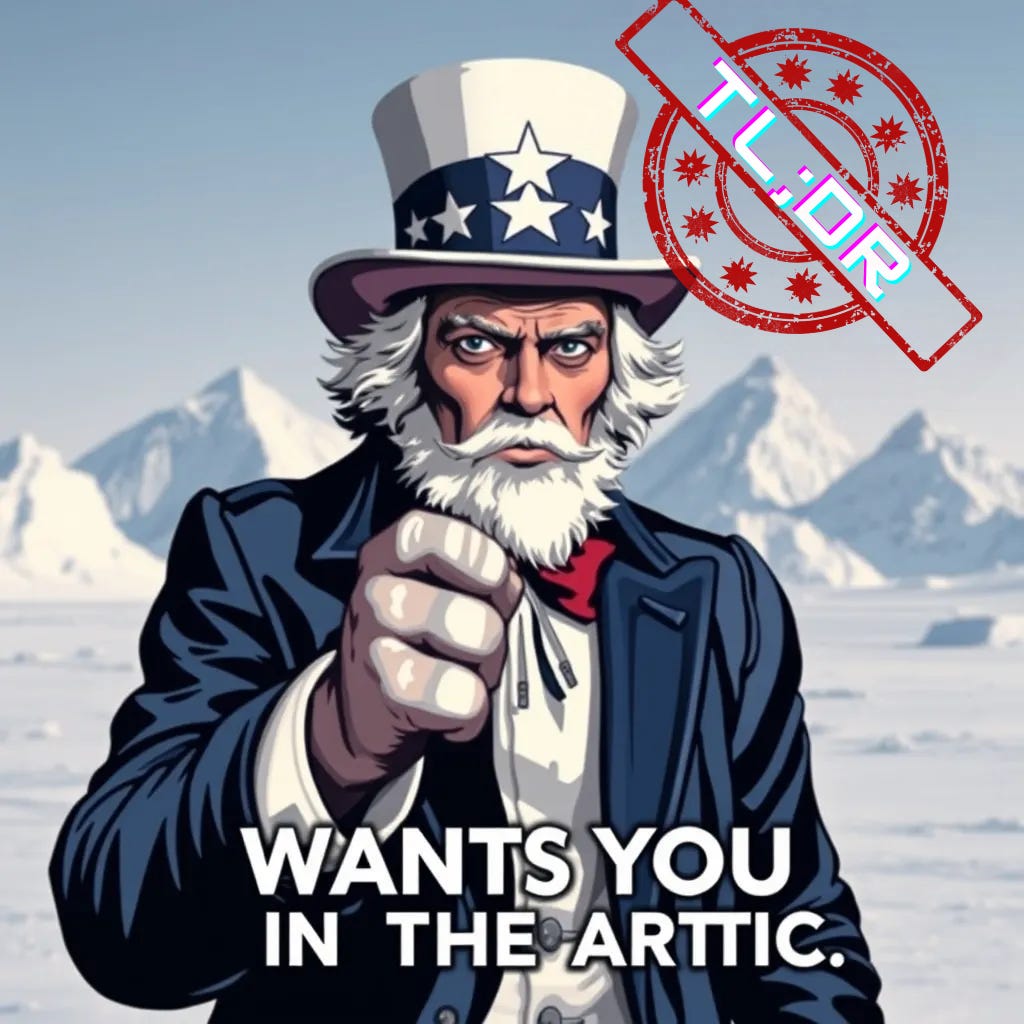It's Getting Hotter in the Arctic (TL;DR)
Russia, the US, and China all know it's not about the ice, but rather what happens when it's gone.
I know you’re busy… That’s why with every deep-dive published, a TL;DR (Too long; Didn’t Read) version will be added. The TL;DR version will have less gifs and images, but you’ll get the gist.
***
Looking for Clues: Signs of the Reconfiguration in the Arctic:
The Arctic, spanning 20 million kilometers, is more than a frozen wasteland. It holds vast resources and strategic value, attracting global powers. Despite its harsh conditions, the Arctic's potential for resource extraction and strategic advantages makes it a focal point for international competition.
While the Arctic is currently still mostly frozen, underneath the (icy) surface a hidden race is afoot🏇
🔎Clue #1: Enter Climate Change
The Arctic is experiencing rapid ice loss due to climate change, with significant annual declines in sea ice and permafrost. This leads to global consequences like methane emissions and ecosystem disruptions.
These consequences are central to the reconfiguration that is taking place within the Arctic.
🔎Clue #2: Increased Attention Towards the Arctic?
Changing Arctic landscape meets increased activities of world powers:
Russia: Prioritizes Arctic dominance with military build-up and strategic partnerships with China.
NATO and Uncle Sam: Respond with increased military presence and infrastructure investments, bolstered by Finland and Sweden joining NATO.
China: Despite lacking direct access, seeks to establish a Polar Silk Road as part of its Belt and Road initiative.
🔎Clue #3: Everyone Else - Pile On!
If that’s not enough, the changes to the Arctic lead to additional players to dive head-in first, with NGOs advocate for environmental protection, while companies explore resource extraction opportunities. Some shipping companies pledge sustainable exploration.
This renewed interest only underscores how deep the changes to the Arctic are, causing many stakeholders to recognize that unless action is taken, the Arctic will soon be… unrecognizable.
🔎Clue #4: Ships, Ahoy!
The Arctic's melting ice opens new shipping routes, such as the Northwest Passage and the Northern Sea Route, offering shorter and more cost-effective paths than traditional routes like the Panama and Suez Canals. This shift has significant geopolitical and economic implications, making control over these routes a key prize in the Arctic race.
Reconfiguration at Play: What the F is Going On?
The increased attention to the Arctic is a prime example of reconfiguration due to climate change. As the Arctic ice thaws, revealing an ice-free future, world powers like Russia, the US, and China are placing strategic bets on the region's potential. This shift represents a significant change in global power dynamics, with nations adapting their strategies to benefit from new opportunities rather than attempting to halt climate change's impacts.
This reconfiguration means, if nothing else, a deep and fundamental change in the dynamics governing the Artic region.
The Big Picture:
The race for the Arctic highlights a unique response to climate change, focusing on adaptation and strategic advantage rather than prevention. This reconfiguration reflects a shift in global dynamics, with nations and companies preparing for an ice-free future. The changes in the Arctic, while concerning, are undeniable and prompt a reevaluation of strategies to stay ahead of the curve.
As we continue to explore the Reconfiguration, we will find similar and dissimilar examples of fundamental dynamic changes that, whether we like it or not, are taking place.
***
If you’ve liked this TL;DR, check out the original. Fun intended!



